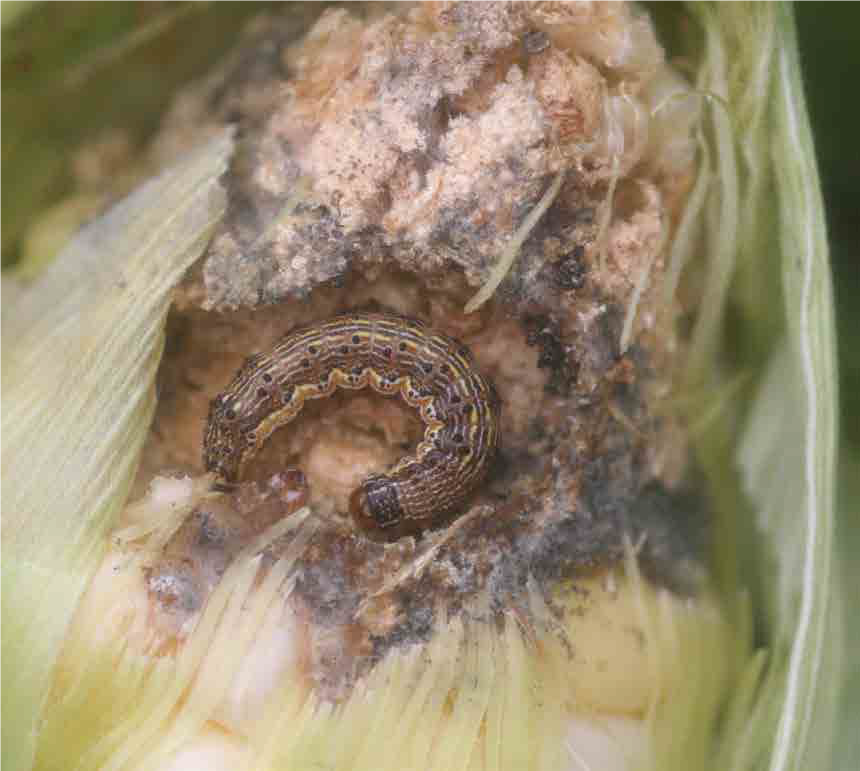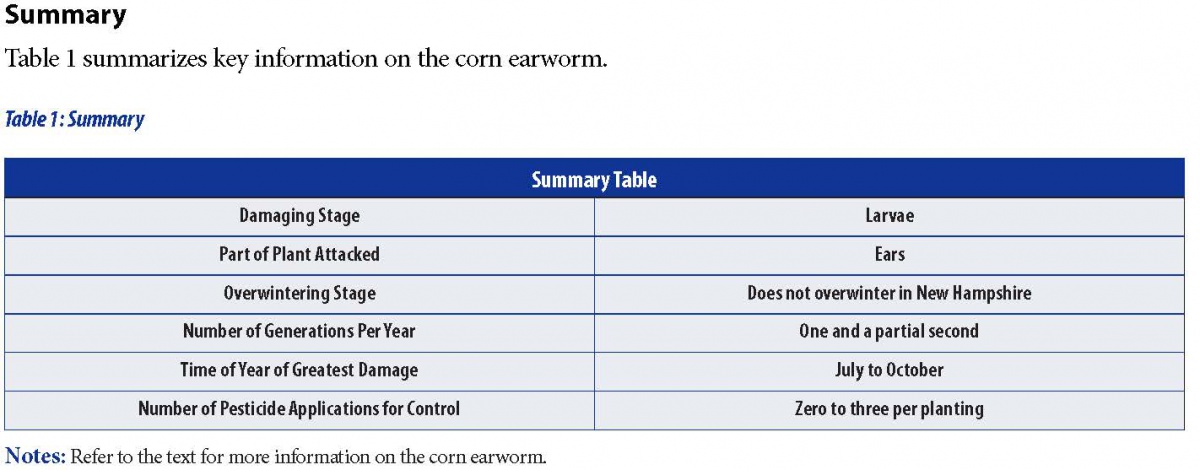The corn earworm, Heliothis zea, is considered one of the worst pests of sweet corn. It might go undetected until harvest time when it is discovered by customers. It has a world-wide distribution and is a major problem in the south. The corn earworm is not only a pest of corn, but also of tomato and cotton, where it is known as the tomato fruitworm and the cotton bollworm, respectively.

State University, Bugwood.org.
Description
Corn earworm larvae vary in color: some are green, some are pinkish-brown, and some are nearly black. Larvae can grow very large, about 1½" long when full-grown, with alternating light and dark stripes which run the length of their bodies. When viewed closely, their bodies have tufts of short bristles, their head capsules are light orange-yellow, and their thoracic legs are black.
The adult moths vary in color from creamy-yellow to olive-tan. They are covered with irregular lines and spots; one of the spots characteristically shows through to the underside of the wing.
The eggs are laid singly on fresh corn silks, and are shaped like a hemisphere with ridges along their sides.
Life Cycle
The corn earworm does not overwinter in New Hampshire. Adult moths fly north in the summer, with the first moths usually arriving here sometime between July 1 and August 15. Depending on weather conditions, many waves of corn earworm moths may come to New Hampshire throughout the summer.
Female moths lay their eggs singly, preferably on fresh corn silk. A single moth will lay 500 to 3000 eggs. The eggs hatch in 2-10 days and the larvae begin to feed on the silk. They stop feeding when the silk becomes dry, then move to the tip of the ear, where they feed on the kernels for 2-4 weeks. After the 5th molt, the larvae drop to the ground to pupate, emerging later as adult moths. Late corn is the most vulnerable, since it can be attacked by both local and migrating moths.

Management
IPM Strategies:
- Monitoring - Pheromone traps can be used to monitor corn earworm flights. For more information, refer to the fact sheet "Setting up Traps to Monitor Sweet Corn Insects in New Hampshire": http://extension.unh.edu/resources/files/Resource002125_Rep3138.pdf.
- Organic Control - Hand application of vegetable oil to fresh silks can work if it is done correctly and at the right time. It is a labor-intensive method that may not be economically viable.
- Chemical Control - Begin applications of insecticides when moths arrive and when 25% of the ears show silk. Insecticides are directed at the fresh silk. Spray intervals vary with earworm moth abundance, but typically range from 3 to 7 days. Once silks have dried, insecticide application is no longer effective. Corn earworm control is not necessary on plantings of varieties maturing by mid to late July in New Hampshire.
Consult the New England Vegetable Management Guide or your county Agricultural Field Specialist for specific recommendations.
 Stop! Read the label on every pesticide container each time before using the material. Pesticides must be applied only as directed on the label to be in compliance with the law. All pesticides listed in this publication are contingent upon continued registration. Contact the Division of Pesticide Control at (603) 271-3550 to check registration status. Dispose of empty containers safely, according to New Hampshire regulations.
Stop! Read the label on every pesticide container each time before using the material. Pesticides must be applied only as directed on the label to be in compliance with the law. All pesticides listed in this publication are contingent upon continued registration. Contact the Division of Pesticide Control at (603) 271-3550 to check registration status. Dispose of empty containers safely, according to New Hampshire regulations.
Download the resource for the complete factsheet.

